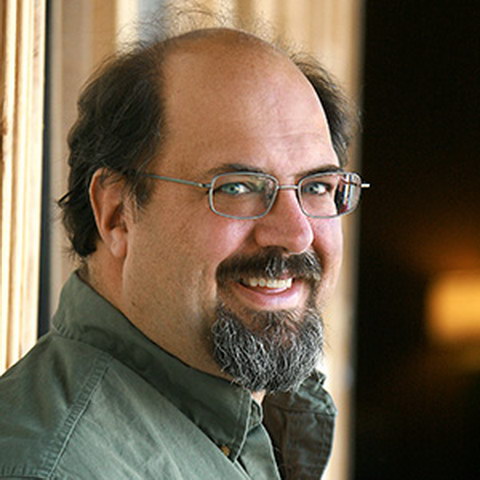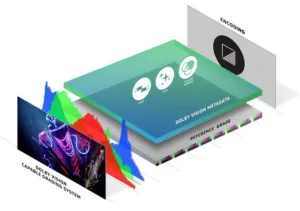In a Society of Motion Picture and Television Engineers (SMPTE) Emerging Technology Webcast on October 6th, Thad Beier, Director of Image Platform Workflow at Dolby Laboratories, discussed the techniques of color and dynamic range grading content for high dynamic range (HDR) cinema. Dolby Cinema, with 35 partner locations in the United States, Europe and China, is a key player in the HDR cinema business, although there are other players (e.g. IMAX). Dolby expects there to be 200 or more HDR theaters world-wide within two years.
 Thad Beier of Dolby Laboratories
Thad Beier of Dolby Laboratories
One of the issues with HDR cinema is that there are very few locations worldwide compared to the very large number of conventional standard dynamic range (SDR) DCI cinema installations. Therefore, for HDR cinema content to be commercially viable, it normally must be shown in conventional SDR DCI cinema installations as well as HDR theaters.
Beier first discussed the two key differences between SDR and HDR cinema content, both of which affect how the content should be color graded. These differences are shown in the table.
| SDR cinema content | HDR cinema content | |
| Example | DCI cinema | Dolby Cinema |
| Dynamic Range | 0.024 – 48 cd/m² (14 Ft.-L., 2000:1 contrast or about 11 stops) | 0.0001 – 108 cd/m² (31.5 Ft.-L., 1,080,000:1 contrast or about 20 stops) |
| Color Gamut & EOTF | SMPTE RP 431-2:2011 colorimetry (DCI P3) and transfer characteristics | 95% of Rec. 2020 color gamut, D65 white point, SMPTE 2084 EOTF |
Simultaneous human eye sensitivity, i.e. brightness range within a single image where the human eye can perceive detail in both the high and low brightness parts of the image, is about 10,000:1 or about 13.3 stops. Most modern digital cinema cameras use for HDR acquisition have about 14 stops of dynamic range, although there are specialized HDR cameras that cover more than 14 stops. The job of the colorist working on HDR cinema content is to make the 14 stops from the camera look good on both the 20 stops of HDR cinema projectors and the 11 stops of a standard DCI cinema projector.
It would seem as if the 20 stop range of HDR cinema is not needed since both the eye and the camera have about a 14 stop range. These ranges are both scene-referenced and not absolute, however. Both the human eye and cameras can cover 20 stops and more, when referencing different scenes.
For example, the cinematographer shooting a scene at night might use a very wide aperture and high ISO setting, and in a bright daytime scene using the same camera might use a small aperture and an ND filter. This could cause the scene-referred dynamic range of the raw content for the night and day scenes to be similar. Without color grading, these two scenes would appear at about the same brightness on a normal display. During color grading, the colorist and director can push the dark scene darker, and the bright scene brighter, potentially to the full 20 stop range of the projector, even though the raw camera content is only 14 stops.
Based on Dolby’s experience, Beier suggests that the mid-tones – in particular skin tones – be kept at a similar brightness that they would be on DCI projectors. Beier suggests using the extended brightness to make highlights “pop”, or to allow details in highlights that were traditionally clipped.
Dolby’s approach to color grading HDR cinema content is to create an HDR ‘uber’ master, with color grading for the higher dynamic range and the wider color gamut of the HDR cinema. This master is then used as input to creating the SDR master. During the creation of the SDR master, all the metadata needed to have the content look as good as possible on a DCI projector is added into the HDR uber master. This metadata is in the form of “trims” that tell the HDR to SDR conversion process what gets crushed or clipped and how the tone curves are adjusted. In theory, this HDR master with metadata could then be fed into a DCI projector. In practice, no current DCI projector will accept this metadata and the HDR to SDR conversion is done automatically off-line, creating a standard DCI cinema package. In addition, Dolby has developed a Content Mapping Unit (CMU) that will use the metadata do the conversion in real-time. (Note: the CMU is actually software that runs on a Dolby-approved workstation plus video card.) Feed the HDR uber master content into the CMU and SDR content comes out, ready for projection or display in the post-production editing suite. The CMU will not only output SDR DCI, it can output television signals optimized for TVs in the 100 cd/m² – 1200 cd/m² range.
The trim controls used by Dolby are based on the American Society of Cinematographers’ Color Decision List (ASC’s CDL). These include “slope, offset, power” as well as a few other trims that are essential for saturation adjustments going from HDR to SDR.
Dolby ran this process on a piece of sample content for HDR cinema using a Dolby HDR Pulsar monitor with 4,000 cd/m², P3 colorimetry, 0.005 cd/m² black level. As part of the process, they also viewed the content on a Dolby Cinema-grade laser projector. According to Beier, the color grading of the sample content took about three weeks to create the HDR cinema master without the SDR metadata. This was about the time it would have taken to create a SDR DCI master from the same original camera files. Then, using the Dolby-developed tools, it took a colorist about three hours to add in the metadata needed to generate the SDR DCI version. Beier said that about 90% of the scenes actually needed no trims at all and the HDR and SDR version would be identical.
Dolby Vision color grading and metadata for both cinema and TV. The reference grade is the HDR grade and the metadata tells the receiver how to trim the HDR version to produce the SDR version.
An added benefit Beier claimed for the HDR uber master approach is that the colorist and the director believed the SDR DCI master created by this process was actually better than could be produced by creating the SDR master directly from the camera files. Beier attributed this to the fact that the colorist and director could see more in the HDR process and better judge color and dynamic range.
In theory, the HDR uber master could be used to create other versions of the content, including Dolby Vision, HDR10 and SDR versions for TV. Beier did not discuss this in any detail and focused on HDR and DCI cinema versions of the content.
Beier said that there have been about fifty films created for HDR cinema projection over the last year, although he did not say how many of these were color-graded using the process discussed in this article. He added there are three commercial HDR grading facilities in the Los Angeles area as well as two more at movie studios.
While currently there are two cinema projector types – HDR and DCI cinema, projector companies are working on higher dynamic range projectors than the standard 2000:1 DCI projectors. These projectors will have about 8000:1 contrast or about 13 stops, between the 11 stops of DCI and the 20 stops of Dolby Cinema. Content will, of course, be needed for movie theaters with these intermediate dynamic range projectors. With the HDR uber master approach, Beier said it would be easy to create content at any dynamic range desired from the uber master.
Mr. Beier’s webcast will be viewable on demand at the SMPTE Webcast on Demand web page. Viewing it is free to SMPTE members or $49 for non-members. As of this writing, it has not yet been posted.
Dolby has also posted an 18 minute video on Vimeo, presented by Thomas Graham, Sr. Manager – Content Solution at Dolby, that explains Dolby Vision for cinema, TV and other platforms, including the post-production Dolby Vision workflow. He says the metadata can not only produce SDR version of the content, but the system can be used to produce a “generic HDR” version, e.g. HDR10. In this video, Graham not only explains the color grading process for HDR cinema and TV, but gives specific brands for Dolby Vision-compatible hardware and software, including a non-Dolby HDR monitor, the 4K (4096 x 2160) Sony PVMX300. –Matthew Brennesholtz

